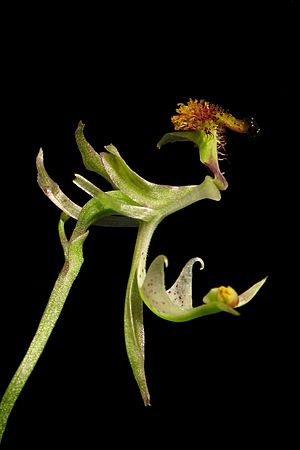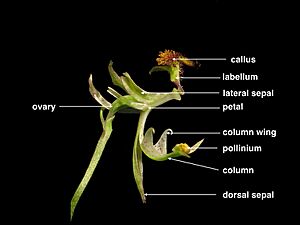Elbow orchids facts for kids
Quick facts for kids Elbow orchids |
|
|---|---|
 |
|
| Arthrochilus latipes in Kakadu National Park | |
| Scientific classification |
|
| Kingdom: | Plantae |
| Clade: | Tracheophytes |
| Clade: | Angiosperms |
| Clade: | Monocots |
| Order: | Asparagales |
| Family: | Orchidaceae |
| Subfamily: | Orchidoideae |
| Tribe: | Diurideae |
| Subtribe: | Drakaeinae |
| Genus: | Arthrochilus F.Muell. |
| Type species | |
| Arthrochilus irritabilis F.Muell.
|
|
| Synonyms | |
|
|
Arthrochilus, also known as elbow orchids, is a group of about fifteen types of flowering plants. These unique plants belong to the orchid family and grow in Australia and New Guinea. Elbow orchids are famous for how they get pollinated. Male thynnid wasps try to mate with the flowers, thinking they are female wasps. While the wasp is held by special hooks, the flower's pollen (called pollinium) sticks to the insect. This helps the orchid make new seeds.
Contents
What Do Elbow Orchids Look Like?
Elbow orchids are plants that grow in the ground. They live for many years but lose their leaves each year (they are deciduous). Most have a single, oval-shaped underground storage part called a tuber. One type, A. huntianus, does not have a true tuber.
Some elbow orchids can form large groups. They do this by growing new plants from special roots that spread out. The main stem of the plant is short and stands upright. It has thin, leaf-like parts at each joint. There are usually up to six leaves near the bottom of the plant. Sometimes these leaves form a circle, like a rosette, around the stem.
The Unique Flower Structure
Elbow orchids have dull-colored flowers that grow along a thin, wiry stalk. The top part of the flower, called the dorsal sepal, is often bigger than the side sepals. Its sides curve inward. The side sepals and petals are attached to the base of the flower's central part, called the column. The petals are similar to the sepals but smaller.
The most special part is the labellum, which is like the orchid's "lip." It has a flexible "claw" that connects it to the column. This labellum is covered with feathery hairs and club-shaped bumps. These make the labellum look like a female wasp without wings. The column also has two pairs of "wings." Two wings surround the flower's reproductive parts, and two larger, hook-like wings are on either side of the column.
Most elbow orchids bloom in the summer. After flowering, they produce a smooth, dry fruit called a capsule. This capsule opens up to release many tiny, winged seeds.
How Did Elbow Orchids Get Their Name?
The genus Arthrochilus was first officially described in 1858. This was done by a scientist named Ferdinand von Mueller. He published his description in a book called Fragmenta phytographiae Australiae. At the same time, Mueller also described Arthrochilus irritabilis, which is considered the main example species for the group.
The scientific name Arthrochilus comes from two Ancient Greek words. Arthron means "joint," and cheilos means "lip." This name refers to the labellum, or "lip," of the flower, which is hinged and moves like a joint.
Where Do Elbow Orchids Grow?
Elbow orchids can be found in almost all parts of Australia, except for Western Australia. They also grow in southern Papua New Guinea and on the Torres Strait Islands.
Most types of elbow orchids live in warm, wet, tropical areas. However, A. huntianus grows in eastern Australia. A special kind of A. huntianus (called subspecies nothofagicola) even grows in Tasmania. The tropical species usually grow and flower during the summer wet season. They often prefer sandy soil in forests or woodlands.
How Do Elbow Orchids Pollinate?
The labellum of elbow orchids is amazing because it looks just like a female thynnid wasp. These wasps belong to a group called Thynnidae. Male thynnid wasps are attracted to the orchid's labellum, thinking it's a female wasp. They try to fly away with this "dummy female."
When the male wasp tries to grab the labellum, it is pushed head-first against the flower's column. The special hooked wings on the column hold the wasp in place. This gives enough time for the flower's pollen (called pollinia) to stick to the wasp's back. If the wasp is already carrying pollen from another elbow orchid, that pollen gets pressed against the flower's stigma, helping the orchid to be pollinated.
For three types of elbow orchids, scientists have found that only one specific kind of wasp, from the genus Arthrothynnus, does the pollinating. Sometimes, with tropical species, the wasps struggle so much with the labellum that they can even tear it off! Other orchids also use thynnid wasps for pollination, but only Arthrochilus flowers have these unique restraining hooks on their labellum.
Species List
Here is a list of some recognized elbow orchid species:
- Arthrochilus apectus D.L.Jones - untidy elbow orchid (Qld.)
- Arthrochilus aquilus D.L.Jones - dark elbow orchid (Qld.)
- Arthrochilus byrnesii Blaxell - sandstone truffle orchid (N.T., W.A.)
- Arthrochilus corinnae D.L.Jones - swamp elbow orchid (Qld.)
- Arthrochilus dockrillii Lavarack - green truffle orchid (Qld.)
- Arthrochilus huntianus (F.Muell.) Blaxell - common elbow orchid (N.S.W., Tas., Vic., S.A.)
- Arthrochilus irritabilis F.Muell. - clubbed elbow orchid (Qld.)
- Arthrochilus laevicallus Ormerod (Papua New Guinea)
- Arthrochilus latipes D.L.Jones - robust elbow orchid (N.T.)
- Arthrochilus lavarackianus (D.L.Jones) Lavarack - glaucous truffle orchid (Qld.)
- Arthrochilus oreophilus D.L.Jones - montane elbow orchid (Qld.)
- Arthrochilus prolixus D.L.Jones - wispy elbow orchid (N.S.W., Qld.)
- Arthrochilus rosulatus D.L.Jones - rosetted elbow orchid (Qld.)
- Arthrochilus sabulosus D.L.Jones - spotted elbow orchid (Qld.)
- Arthrochilus stenophyllus D.L.Jones - narrow-leaved elbow orchid (Qld.)
See also
 In Spanish: Arthrochilus para niños
In Spanish: Arthrochilus para niños


